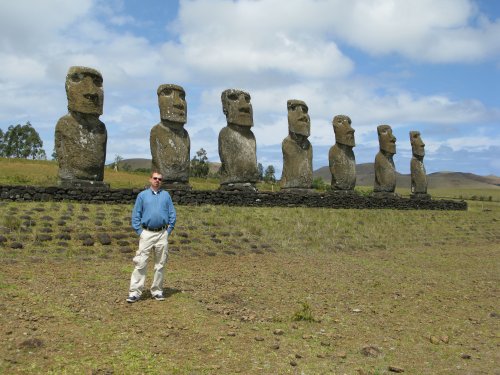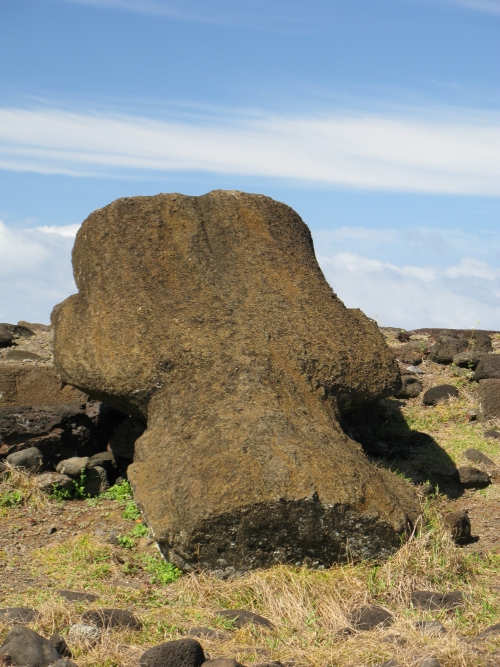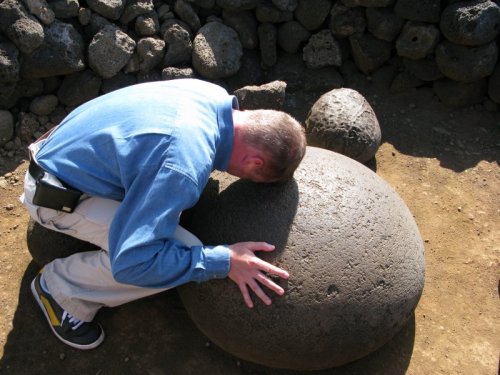Easter
Island - October 2008

Easter Island is often called the most isolated and remote inhabited island in the world. It is 2237 miles from the Chilean mainland and 1290 from Pitcairn Island, the nearest inhabited island.
The unfortunate reality is that Easter Island is not really as remote or isolated as the tourist websites would have you believe. There are almost daily flights by LAN Chile to Easter island from Santiago and Tahiti. Although geographically remote, Easter Island is 'just' 5½ hours from Santiago; admittedly a long and not inexpensive flight but readily accessible to those that are prepared to make the trip.
On arriving at Santiago airport LAN offered me an upgrade to business class for UD$225 so I took advantage of the offer! The flights out to Easter Island are often full so they offer the upgrades to ensure maximum capacity.
The aircraft looked new; the business class service was excellent and the in
flight entertainment offered great choice. It put British Airways to shame.
Easter Island has
changed completely in recent history. In the late 1950s Thor
Heyerdahl chartered a ship and organised an expedition to Easter island
spending many months in archaeological excavation and discovery.
His book, Aku Aku, became a best seller.
In 1967 the
airport opened and commercial flights started to the island from Chile.
Flights from Tahiti began a year later. The airstrip is the
longest in the pacific islands having been extended as an
emergency landing place for the U.S. Space Shuttle.
Electricity arrived on the island in the 1970s,
and in the early 1990s a film crew arrived to shoot the movie 'Rapa
Nui'. The movie is based tenuously on the legends of the island;
Kevin Costner was the producer and the movie was an expensive flop.
However it does capture some of the excitement of the Easter
Island legends and many of the locals were employed as extras in the
movie. Even then the islanders wore traditional dress and rode on
horesback. Now everyone wears blue jeans and drives a car or
truck.
Of course people come to Easter Island to look upon the
enigmatic moai. The legends of the moai and the cult of the
birdman fascinate people.
The history of Easter
Island is controversial. There is disagreement as to the date the
island was first colonized; some say 300BC, others 700AD and the latest
findings point to a date around 1200AD.
According to legends recorded by missionaries in the 1860s, from the time Hotu Matua (the legendery first settler and supreme chief) arrived on the island there was a class system, with an ariki, or king, with a god-like power. The moai were part of the culture of ancestral worship during this time.
It would seem the islanders were quite obsessive about the creation of the moai, as there are close to 900 statues on the island. Most of the moai can be found at the Rano Raraku crater, the 'nursery' for the moai.
It is believed that the as statue making increased, the supplies of timber gradually became
scarce. The lack of trees meant that canoes could no longer be built,
restricting offshore fishing. Without canoes, they could not set off for another
island. The Rapanui found themselves trapped in a degrading environment.
The size of the population at its peak is
a matter of debate; some suggest
7,000; others a higher number. Whatever the population, when combined
with environmental deterioration, it was more than the island could
sustain.
A powerful warrior class (matato’a) emerged as the mana of the ariki mau
declined; land was seized and enemy villages destroyed. Ceremonial shrines were
desecrated and the statues toppled. One result of this power shift was the
establishment of a new religion by the matato’a: the Birdman Cult. This cult
served to alternate leadership between rival groups from year to year, and the
selection of a winner (or "Birdman") was based upon a contest to
acquire the first bird egg of the season. Thus the Rapanui turned from their old
religion to a new creator god, Makemake, and to rituals based on fertility.
The first photos on this page are of the Ahu Akivi site. This site with seven moai was restored by William Mulloy in 1960. Unlike other sites on the island, Ahu Akivi is inland with the moai facing the ocean. The unusual location prompted speculation that Ahu Akivi is a 'celestial observatory', but the moai looked over a large village that is now in ruins.
The next photo is of the Ana Kai Tangata cave, which is tied to the birdman cult, with the remains of paintings visible in the cave.
At Ahu Akahanga there are many fallen maoi. The legendary first king of the island, Hotu Matua, is said to be buried here. Nearby is the Navel of the World.
Te Pito O Te Henua - The Navel of the World - is a large magnetic stone near the Akahanga site.
The Rapa Nui people believe that touching your forehead to the
stone will bring you mana!

Ahu Akivi, restored by William Mulloy in 1960

The seven Ahu Akivi moai are inland and look towards the ocean

A view from the cave at Ana Kai Tangata looking out on the ocean

The coastline between Hanga Te'e and Akahanga

A fallen moai at Akahanga, the mythical burial place of King Hotu Matua

A
toppled moai at Akahanga

Te
Pito O Te Henua - The Navel of the World


